四年级英语下册Unit5FreeTimeStoryTime教学设计人教新起点
【人教版】(新起点)四下:Unit 5《Free Time》(Fun Time)教案
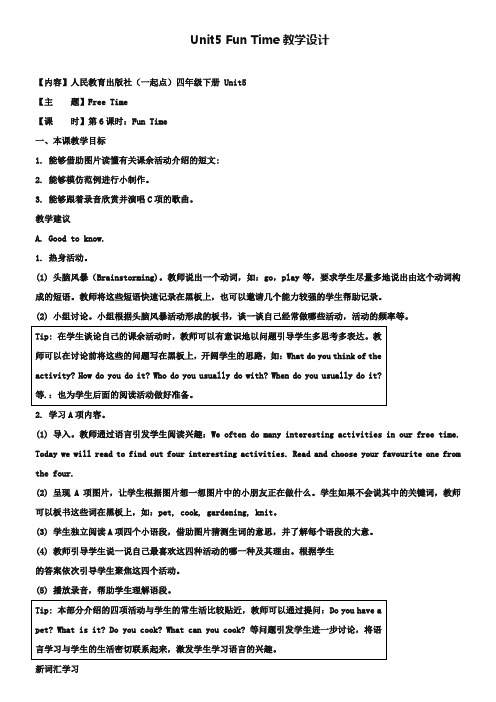
Unit5 Fun Time教学设计【内容】人民教育出版社(一起点)四年级下册 Unit5【主题】Free Time【课时】第6课时:Fun Time一、本课教学目标1. 能够借助图片读懂有关课余活动介绍的短文:2. 能够模仿范例进行小制作。
3. 能够跟着录音欣赏并演唱C项的歌曲。
教学建议A. Good to know.1. 热身活动。
(1) 头脑风暴(Brainstorming)。
教师说出一个动词,如:go,play等,要求学生尽量多地说出由这个动词构成的短语。
教师将这些短语快速记录在黑板上,也可以邀请几个能力较强的学生帮助记录。
(2) 小组讨论。
小组根据头脑风暴活动形成的板书,谈一谈自己经常做哪些活动,活动的频率等。
2. 学习A项内容。
(1) 导入。
教师通过语言引发学生阅读兴趣:We often do many interesting activities in our free time. Today we will read to find out four interesting activities. Read and choose your favourite one from the four.(2) 呈现A项图片,让学生根据图片想一想图片中的小朋友正在做什么。
学生如果不会说其中的关键词,教师可以板书这些词在黑板上,如:pet, cook, gardening, knit。
(3) 学生独立阅读A项四个小语段,借助图片猜测生词的意思,并了解每个语段的大意。
(4) 教师引导学生说一说自己最喜欢这四种活动的哪一种及其理由。
根据学生的答案依次引导学生聚焦这四个活动。
(5) 播放录音,帮助学生理解语段。
新词汇学习pet: 宠物,一般指家养的动物,如猫、狗等,也可以是其他动物,如:pet rabbits, pet birds。
可以组成pet shop (宠物商店)和pet food (宠物食品)等短语。
英语人教新起点(一起)四年级下册-Unit 5 Free Time 导学案

英语人教新起点(一起)四年级下册-Unit 5 Free Time 导学案一、教学目标1.通过本节课的学习,让学生掌握日常生活中兴趣爱好的英文表达。
2.能够正确理解并使用以下单词:swim, skateboard, draw, play basketball, ride a bike, computer game, watch TV。
3.能够完成简单的口语交流:问对方空闲时间都做什么,回答自己的空闲时间都做什么。
4.能够阅读简短的英文短文,并从中获取所需信息。
二、教学重点和难点1.教学重点:让学生能够准确理解和使用所学单词和基础句型。
2.教学难点:如何让学生在短时间内准确理解所学内容,并能够运用到日常生活中。
三、教学过程1. 自我介绍老师先做一个简单的自我介绍,提醒学生应该要关注姓名和职业,可以问老师“Hello, what’s your name?”、“What’s your job?”等问题。
2. 预习温故让学生回答以下问题:1.What’s your favourite sport?2.Do you like swimming?3.Do you like playing basketball?3. 听力训练播放听力材料,让学生听录音并回答问题:1.What does Alice like doing?2.Does Tony like skateboarding?3.What does Cindy like doing on weekends?4. 教学新词汇通过画图、图片等方式展示所学单词:swim, skateboard, draw, play basketball, ride a bike, computer game, watch TV。
然后老师与学生一起重复、理解并记忆这些单词。
5. 句型学习1.What do you like doing?2.I like swimming.3.What does he/she like doing?4.He/She likes playing basketball.5.What do you do on weekends?6.I watch TV on weekends.6. 完成练习老师通过板书或口头提问的方式让学生回答以下问题:1.What do you like doing?2.What does he/she like doing?3.What do you do on weekends?7. 阅读短文老师向学生展示一篇短文,让学生先自行阅读,然后回答相关问题:My name is Lily. I am a student from China. I love playingbasketball and swimming. I usually play basketball with my classmates after class. I also like swimming on week ends. It’s very relaxing.1.What’s the writer’s name?2.What does she like doing?3.When does she play basketball?4.When does she go swimming?8. 小结通过以上学习,让学生一起总结课堂内容,归纳所学内容。
人教版英语四年级下册Unit 5《Free Time》(Story Time)教学设计
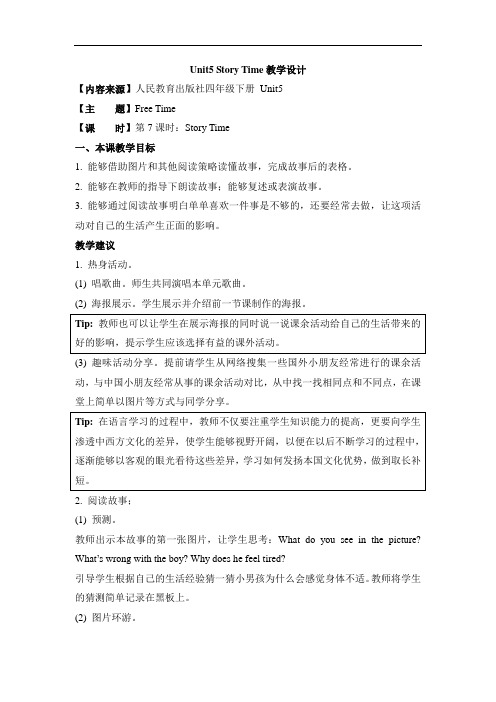
Unit5 Story Time教学设计【内容来源】人民教育出版社四年级下册Unit5【主题】Free Time【课时】第7课时:Story Time一、本课教学目标1. 能够借助图片和其他阅读策略读懂故事,完成故事后的表格。
2. 能够在教师的指导下朗读故事;能够复述或表演故事。
3. 能够通过阅读故事明白单单喜欢一件事是不够的,还要经常去做,让这项活动对自己的生活产生正面的影响。
教学建议1. 热身活动。
(1) 唱歌曲。
师生共同演唱本单元歌曲。
(2) 海报展示。
学生展示并介绍前一节课制作的海报。
(3) 趣味活动分享。
提前请学生从网络搜集一些国外小朋友经常进行的课余活动,与中国小朋友经常从事的课余活动对比,从中找一找相同点和不同点,在课堂上简单以图片等方式与同学分享。
2. 阅读故事;(1) 预测。
教师出示本故事的第一张图片,让学生思考:What do you see in the picture? What’s wrong with the boy? Why does he feel tired?引导学生根据自己的生活经验猜一猜小男孩为什么会感觉身体不适。
教师将学生的猜测简单记录在黑板上。
(2) 图片环游。
教师依次出示故事图片,以提问的方式引发学生思考讨论。
图片①参考提问:What’s the boy’s name? What’s wrong with him? 然后请学生尝试自行阅读图下方的文字。
其余图片环游过程都依据图片①的教学步骤进行。
图片②参考提问:What’s the boy’s problem?Does the boy like exercise?Do you often feel tired?What will you do when you are tired?在讨论图②时,两个主人公说的语言都不是非常直接,学生可能在理解上存在一定困难。
教师可以从女生的话语“Why? We are walking, not running.”入手,引导学生思考:Why does the girl say that they are walking, not running?Why does the boy feel tired even when he is walking?帮助学生理解walking是一项很平缓的运动,男生却仍感觉疲劳,这可能是因为他不经常运动造成的。
人教版(新起点)英语四下unit 5《free time》单元教学目标
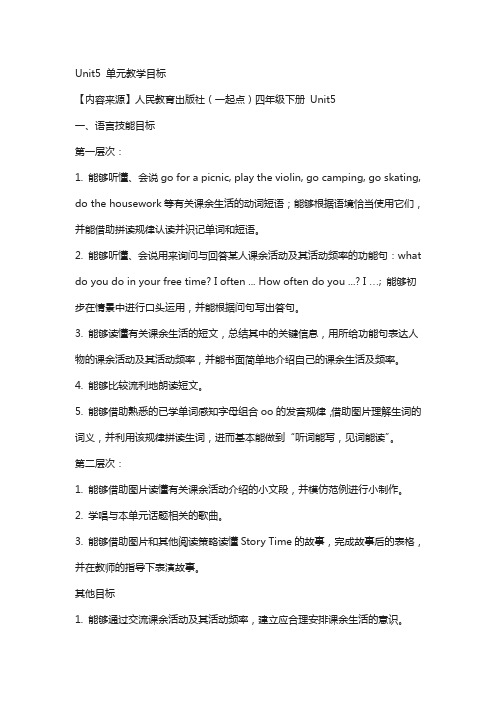
Unit5 单元教学目标【内容来源】人民教育出版社(一起点)四年级下册Unit5一、语言技能目标第一层次:1. 能够听懂、会说go for a picnic, play the violin, go camping, go skating, do the housework等有关课余生活的动词短语;能够根据语境恰当使用它们,并能借助拼读规律认读并识记单词和短语。
2. 能够听懂、会说用来询问与回答某人课余活动及其活动频率的功能句:what do you do in your free time? I often ... How often do you ...? I …; 能够初步在情景中进行口头运用,并能根据问句写出答句。
3. 能够读懂有关课余生活的短文,总结其中的关键信息,用所给功能句表达人物的课余活动及其活动频率,并能书面简单地介绍自己的课余生活及频率。
4. 能够比较流利地朗读短文。
5. 能够借助熟悉的已学单词感知字母组合oo的发音规律,借助图片理解生词的词义,并利用该规律拼读生词,进而基本能做到“听词能写,见词能读”。
第二层次:1. 能够借助图片读懂有关课余活动介绍的小文段,并模仿范例进行小制作。
2. 学唱与本单元话题相关的歌曲。
3. 能够借助图片和其他阅读策略读懂Story Time的故事,完成故事后的表格,并在教师的指导下表演故事。
其他目标1. 能够通过交流课余活动及其活动频率,建立应合理安排课余生活的意识。
2. 能够在活动中认真听同伴发言,并大胆表达自己的观点。
3. 够积极参与课堂活动或游戏,并能与同伴合作完成活动或游戏。
【教学反思】《骆驼和羊》教学设计教材分析:《骆驼和羊》是人教版小学语文二年级上册的一篇选读课文,这是一篇富有哲理的童话故事。
讲的是骆驼和羊都只看到自己的长处,用自己的长处和别人的短处比,谁也不服谁,因而争论不清,最后只好找老牛评理的故事。
这节课的教学重点是让学生懂得一个道理:不能只看到自己的长处和别人的短处,要懂得自己也是有短处的,要学会正确地对待自己和别人。
四年级下册英语教案-Unit5FreeTime课时5人教新起点秋
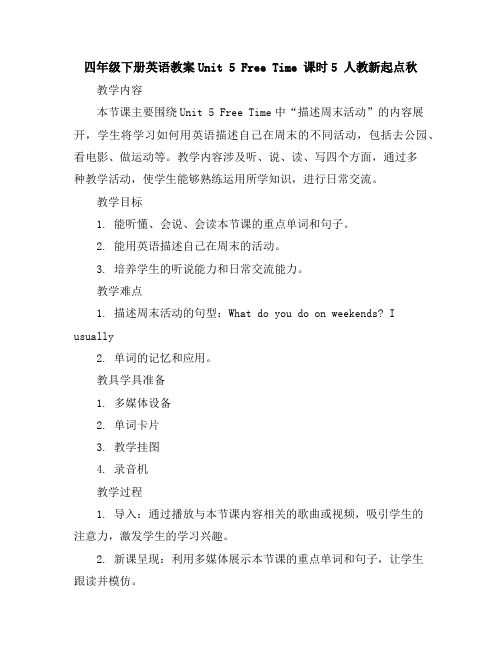
四年级下册英语教案Unit 5 Free Time 课时5 人教新起点秋教学内容本节课主要围绕Unit 5 Free Time中“描述周末活动”的内容展开,学生将学习如何用英语描述自己在周末的不同活动,包括去公园、看电影、做运动等。
教学内容涉及听、说、读、写四个方面,通过多种教学活动,使学生能够熟练运用所学知识,进行日常交流。
教学目标1. 能听懂、会说、会读本节课的重点单词和句子。
2. 能用英语描述自己在周末的活动。
3. 培养学生的听说能力和日常交流能力。
教学难点1. 描述周末活动的句型:What do you do on weekends? I usually2. 单词的记忆和应用。
教具学具准备1. 多媒体设备2. 单词卡片3. 教学挂图4. 录音机教学过程1. 导入:通过播放与本节课内容相关的歌曲或视频,吸引学生的注意力,激发学生的学习兴趣。
2. 新课呈现:利用多媒体展示本节课的重点单词和句子,让学生跟读并模仿。
3. 互动练习:组织学生进行小组活动,让学生用英语描述自己在周末的活动,并进行角色扮演。
4. 巩固提高:通过游戏、竞赛等形式,让学生巩固所学知识,提高听说能力。
板书设计1. Unit 5 Free Time2. 重点单词:park、movie、sport、usually、often等。
3. 重点句子:What do you do on weekends? I usually作业设计1. 书面作业:完成课后练习题,巩固所学知识。
2. 口头作业:回家后,用英语向家长描述自己在周末的活动。
课后反思1. 教师应关注学生在学习过程中的参与度和积极性,及时调整教学方法,提高教学效果。
2. 针对学生的个体差异,教师应给予不同的指导和帮助,使每个学生都能在原有基础上得到提高。
3. 教师应加强与学生的互动,提高学生的听说能力和日常交流能力。
通过本节课的学习,学生能够掌握描述周末活动的英语表达方式,提高自己的听说能力和日常交流能力。
英语人教新起点(一起)四年级下册-Unit 5 Free Time 说课稿
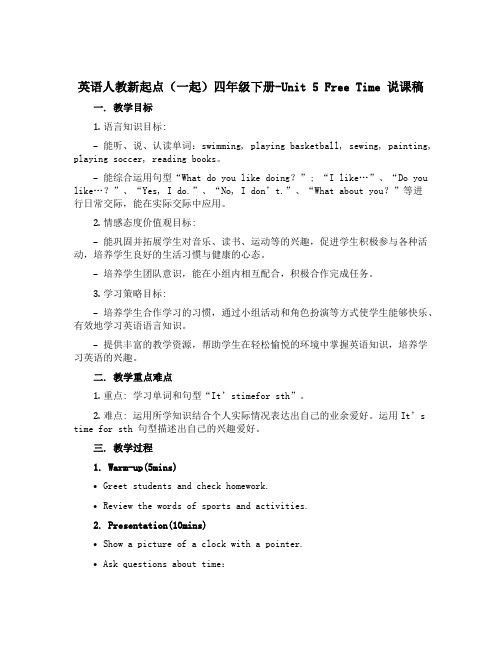
英语人教新起点(一起)四年级下册-Unit 5 Free Time 说课稿一. 教学目标1.语言知识目标:–能听、说、认读单词:swimming, playing basketball, sewing, painting, playing soccer, reading books。
–能综合运用句型“What do you like doing?”; “I like…”、“Do you like…?”、“Yes, I do.”、“No, I don’t.”、“What about you?”等进行日常交际,能在实际交际中应用。
2.情感态度价值观目标:–能巩固并拓展学生对音乐、读书、运动等的兴趣,促进学生积极参与各种活动,培养学生良好的生活习惯与健康的心态。
–培养学生团队意识,能在小组内相互配合,积极合作完成任务。
3.学习策略目标:–培养学生合作学习的习惯,通过小组活动和角色扮演等方式使学生能够快乐、有效地学习英语语言知识。
–提供丰富的教学资源,帮助学生在轻松愉悦的环境中掌握英语知识,培养学习英语的兴趣。
二. 教学重点难点1.重点: 学习单词和句型“It’stimefor sth”。
2.难点: 运用所学知识结合个人实际情况表达出自己的业余爱好。
运用It’s time for sth 句型描述出自己的兴趣爱好。
三. 教学过程1. Warm-up(5mins)•Greet students and check homework.•Review the words of sports and activities.2. Presentation(10mins)•Show a picture of a clock with a pointer.•Ask questions about time:。
四年级英语下册Unit5FreeTimeLet’sCheck导学案人教新起点
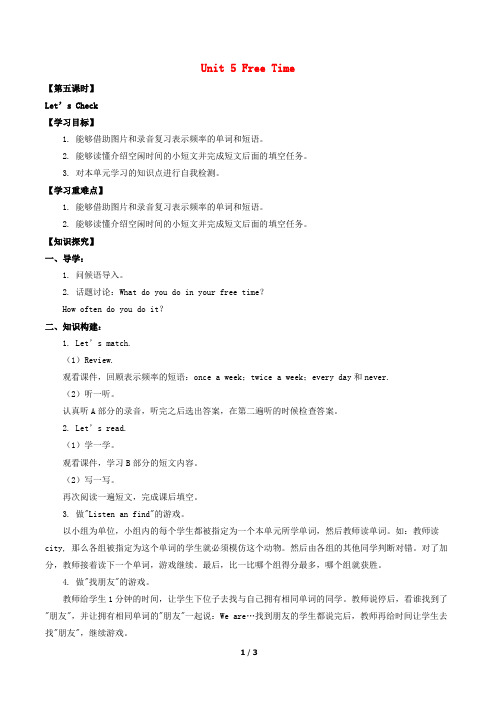
Unit 5 Free Time【第五课时】Let’s Check【学习目标】1. 能够借助图片和录音复习表示频率的单词和短语。
2. 能够读懂介绍空闲时间的小短文并完成短文后面的填空任务。
3. 对本单元学习的知识点进行自我检测。
【学习重难点】1. 能够借助图片和录音复习表示频率的单词和短语。
2. 能够读懂介绍空闲时间的小短文并完成短文后面的填空任务。
【知识探究】一、导学:1. 问候语导入。
2. 话题讨论:What do you do in your free time?How often do you do it?二、知识构建:1. Let’s match.(1)Review.观看课件,回顾表示频率的短语:once a week;twice a week;every day和never.(2)听一听。
认真听A部分的录音,听完之后选出答案,在第二遍听的时候检查答案。
2. Let’s read.(1)学一学。
观看课件,学习B部分的短文内容。
(2)写一写。
再次阅读一遍短文,完成课后填空。
3. 做"Listen an find"的游戏。
以小组为单位,小组内的每个学生都被指定为一个本单元所学单词,然后教师读单词。
如:教师读city, 那么各组被指定为这个单词的学生就必须模仿这个动物。
然后由各组的其他同学判断对错。
对了加分,教师接着读下一个单词,游戏继续。
最后,比一比哪个组得分最多,哪个组就获胜。
4. 做"找朋友"的游戏。
教师给学生1分钟的时间,让学生下位子去找与自己拥有相同单词的同学。
教师说停后,看谁找到了"朋友",并让拥有相同单词的"朋友"一起说:We are…找到朋友的学生都说完后,教师再给时间让学生去找"朋友",继续游戏。
5. 自我检测。
三、巩固训练:1. 翻译下列短语。
(1)从不_________________(2)一周一次________________(3)一周两次_________________(3)一周三次_______________2. 选出不同类的一项。
人教版(新起点)英语四年级下册Unit 5《Free Time》(Let’s Spell)教学设计

Unit5 Let’s Spell教学设计【内容来源】人民教育出版社(一起点)四年级下册Uni5【主题】Free Time【课时】第4课时:Let’s Spell一、本课教学目标1. 能够借助熟悉的已学单词感知字母组合oo的发音规律。
2. 能够借助图片理解生词的词义,并利用该规律拼读生词,进而基本能做到“听词能写,见词能读”。
3. 能够熟练朗读本课小韵文,感受英语的韵律和节奏。
教学建议A. Listen, point and repeat.1. 热身活动。
听音写词。
每个学生准备一张白纸,教师随机说出包含本册第一至第四单元学习过的符合字母组合发音规律的词汇。
学生快速在白纸上拼出单词。
如:ng,ng, shopping.然后教师在黑板上写出答案,学生根据答案自行评价。
(2) 教师请学生看A项所给的单词,让学生找一找它们的共同点。
尝试两人一组读一读这些单词。
引人本课字母组合oo的学习。
(3) 教师播放A项录音,学生打开课本,听录音并指着相应的单词,初步感知字母组合oo在单词中的发音。
(4) 学生尝试说说字母组合oo在单词中的发音。
(5) 教师播放录音,学生指着相应的单词并大声跟读。
(6) 学生小组之间互相读一读A项单词。
B. Read aloud. Then listen and check1. 读一读。
请学生自己读一读B项的词汇。
教师引导学生尝试分辨哪一组词汇读长音,哪一组读短音。
2. 听一听,评一评。
同伴两人一组,依次朗读B部分的词汇。
然后教师播放录音,学生互相评价朗读情况。
3. 快速辨音游戏。
由于学生还没有发现、归纳与总结字母组合oo发长音与短音的规律,即时辨别已接触过的含字母组合00的单词发音就尤为重要。
恰巧A和B项出现的例词都是实义词。
教师准备B项的一些单词的带图的词卡。
然后,快速出示这12张单词的图片,让全班读出来。
由于长音与短音不易区分,在学生发出单词的语音时,教师要仔细辨别,可请学生再说一遍,这样也是提醒学生注意准确发音,长音要发到位。
四年级下册英语教案 Unit 5 Free Time 人教新起点版

四年级下册英语教案 Unit 5 Free Time 人教新起点版一、教学目标1.学生能够听、说、读、写本单元的单词和句型;2.学生能够在真实情境中运用所学知识表达自己的闲暇生活;3.学生能够运用所学语言技能进行简单的交流。
二、教学重点1.掌握本单元的重点单词和句型;2.能够在真实情境中运用所学知识表达自己的闲暇生活。
三、教学难点1.能够运用所学语言技能进行简单的交流。
四、教学准备PPT,教材,录音设备等。
五、教学过程1. 教学引入通过播放一些趣味闲暇活动的视频等多媒体方式引入,调查学生平时的闲暇时间活动,让学生自由表达。
2. 教学重点1.学习重点单词,快速复习基础单词,并学习新单词,如 basketball,football,listen,read,swim,watch TV等。
2.学习重点句型,如 What do you usually do on Mondays? I usually play basketball. Do you like swimming? Yes, I do. No, I don’t.3. 教学难点1.学生运用所学语言技能进行简单交流。
通过对话、角色扮演等方式,在真实情境中提高学生的交际能力。
4. 教学拓展1.聜视听综合教学方法,激发学生学习兴趣。
2.课外拓展,让学生使用英语描述自己的日常活动等。
六、课堂评价1.学生听懂并会说本单元所教授的单词和句型;2.学生能够在真实情境中运用所学知识表达自己的闲暇生活;3.学生能够运用所学语言技能进行简单交流。
七、教学反思本课教学应用了多种教学方法,让学生能够在轻松、愉快的氛围中学习,掌握本单元重点语言;课堂氛围活跃,学生的积极性受到有效调动。
但在实施过程中,部分学生存在听力障碍,在巩固语言知识时需重点关注。
同时因为时间有限,本堂课的内容有些紧凑,对于部分学生来说可能较为困难。
因此在今后的教学中,需要对课程内容进行更充分的预备教学和教学设计,巩固学生听、说、读、写的基础技能,提高教学效果。
最新人教版新起点英语小学人教新起点四年级下册《Unit 5 Free Time 》公开课教学设计 (1)

TitleA story---A new bow and arrowTeaching aims 语言知识目标:Make the students to understand the story and master the words and the key sentences.1) Words: bow, arrow, shoot, never, winner.2)Sentences:a. I've got a new bow and arrow.b. Girls first.c. Your turn.d.You'rethewinner.e. I dare you to shoot the duck.语言技能目标:1.能根据情境和图片说出单词和句子.2.能在设计的情景中进行简单的英语交流.3.能表演故事.情感态度目标:Make the students to know: We should look after animals and learn to make the right choice in dispute.Teaching focusesMake the students to understand the story and master the words and the key sentences.1) Words: bow, arrow, shoot, never, winner.2) Sentences:a. I've got a new bow and arrow.b. Girls first.c. Your turn.d. You're the winner.e. I dare you to shoot the duck.Teaching difficultie s 1.Make the students to understand the key sentence:I dare you to shoot the duck.2. Make the students to know: We should look after animals and we should learn to make the right choice in dispute.Teaching methodsTPR, situational language teaching and communicative language teaching .TeachingaidsRecorder, pictures and CAI.Teaching stepsStep 1 Warming up 1. show some pictures.2. free talk about the pictures.1.T: look at the screen.T: What's this? A bow.OW pronounce...,so "bow " pronounce..T : Bow , bow, I've got a bow.Can you read this word ? (Teacher shows the word row) T: And the other one? Take it out .T: What's this? An arrow. (Teacher shows the word arrow)Step 2 Presentatio n and drillHow to read it?A pronounce… OW pronounce..., so "arrow " pronounce.. T: Arrow , arrow, I've got a arrow.2.T: I've got a new bow and arrow.(Writing on the board and leading students to read the sentences.)1.T: Look, Who is this?(She is Zhang Juanjuan, she is a winner in Beijing Olympic games.)T: She can shoot.(Lead ing students to read the word and pay attention to o-o.) T: She can shoot. I can shoot.(Teacher does the action.) Can you shoot?2.have a Try.T: Girls first.T: Your turn.6. T: Can you shoot well?.Let's have a competition, OK?(Teacher asks some students to the front and have a competition.)Girls first or boys first.S1: Girls first.S2: I've got a new bow and arrow. I can shoot.S2: Your turn.T: Who is the winner?T: Wow! great! You are the winner.(The students saytogether.)3.T: Now, let's listen to the story " A new bow and arrow. "(Writing on the board.) T:Look, pleasant sheep is coming, and he brings some challenges for us. Can you face these challenges?At first , Let's read the challenge 1?1).What is the story about?2).Who has got a new bow and arrow?4.T:Open your books ,and read follow the tape .This time, we should complete the challenge 2?(课件出示题目)v 1. Where are they?A. In the park.B. In the zoo.v 2. What animal is in the park?A. DogB. Duckv 3. Does Mike shoot the duck?A. Yes.B. No.T: Where are they?(They're in the park.)T: What animal is in the park? (A duck.)T: What colour is the duck?Oh, how beautiful.Can we shoot the duck? (No, never.)T: Why? (We should look after animals.)5. T: But at this time, a boy says “I dare you to shoot the duck.”Show:I dare you to shoot the duck.Teacher lead students to read and understand the sentence.T: Choose the right answer.(A. 我谅你也不敢射那只鸭子)T: Let’s read again.T: Who can read well?Students try to read and act.1Show: Does Mike shoot the duck?A. Yes.B. No.T: Does Mike shoot the duck?T: I think he shoot the duck. Because in this picture, the boy and the gir l says “Wow, great.”Do you agree with me?Ss: No.T: Mike didn’t shoot the duck, why? Where can you find? Ss: No, never.T: never, what’s meaning?T: Let’s read again.T: Who can read well? (Some students act .)T: Does Mike shoot the duck?Ss: No.T: The duck flies away, and Emma says “Thanks, Mike.”Why does Emma say “Thanks, Mike.”?Students say their views.T: Let's say together.Wow! Super! You're the winner.Step3 Consolidati on and summary T: Look, Pretty sheep is coming. Let’s act the story in groups2. Some groups try to act.3. Now, let’s face the challenge 3: Make sentences.1.new arrow. I've got a and bow2. winner . the You're3. I the to duck. dare you shootStudents do the exercise and check the answers.4. T: What do you learn from the story?(Mike is the real winner. Animals are our friends, We should look after them, and we should learn to make the right choice in dispute.)5. T: Look, many people are doing something for animals. But what can we do?Let’s design a poster to tell people to love animals.6. T: Who gets the prizes in this class?Look, there are some words on it. Share it with your friends.7. Teacher summaries the class.T: I'm very happy, because you show yourselves bravely in this class, and you make us remember you.Homework 1.retell the story.2.Design(设计)a poster to tell people to love animals.(选做题)Writing on blackboard Unit 5 Free timeA story--A new bow and arrowshootnever winner I've got a new bow and arrow.Girls first.Your turn.You're the winner.I dare you to shoot the duck.。
四年级下册英语教案-Unit5FreeTime课时1人教新起点秋
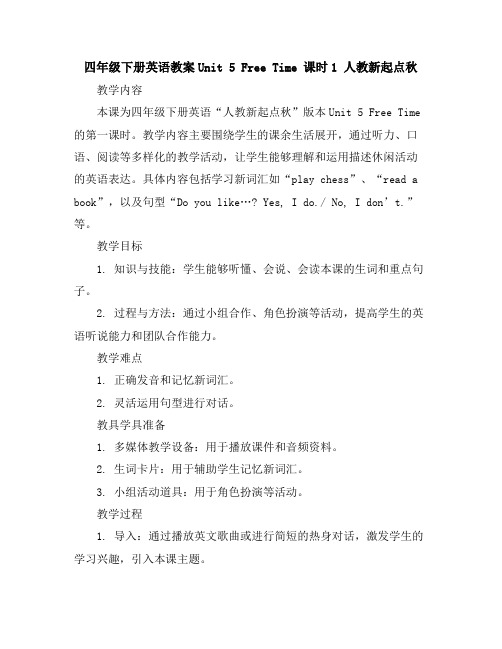
四年级下册英语教案Unit 5 Free Time 课时1 人教新起点秋教学内容本课为四年级下册英语“人教新起点秋”版本Unit 5 Free Time 的第一课时。
教学内容主要围绕学生的课余生活展开,通过听力、口语、阅读等多样化的教学活动,让学生能够理解和运用描述休闲活动的英语表达。
具体内容包括学习新词汇如“play chess”、“read a book”,以及句型“Do you like…? Yes, I do./ No, I don’t.”等。
教学目标1. 知识与技能:学生能够听懂、会说、会读本课的生词和重点句子。
2. 过程与方法:通过小组合作、角色扮演等活动,提高学生的英语听说能力和团队合作能力。
教学难点1. 正确发音和记忆新词汇。
2. 灵活运用句型进行对话。
教具学具准备1. 多媒体教学设备:用于播放课件和音频资料。
2. 生词卡片:用于辅助学生记忆新词汇。
3. 小组活动道具:用于角色扮演等活动。
教学过程1. 导入:通过播放英文歌曲或进行简短的热身对话,激发学生的学习兴趣,引入本课主题。
2. 新授:借助多媒体课件,展示新词汇和句型,并进行讲解、示范和练习。
3. 实践:学生分组进行角色扮演,模拟真实场景,使用本课所学内容进行对话。
4. 巩固:通过听力练习和小游戏,巩固学生对新知识的理解和记忆。
板书设计板书设计将包括本课的主要词汇、句型以及对应的中文翻译,同时辅以简洁明了的图形或示例对话,帮助学生更好地理解和记忆。
作业设计1. 书面作业:完成课后练习题,巩固词汇和句型。
2. 口头作业:学生与家长或同学进行英语对话,分享自己的课余活动。
课后反思课后,教师应反思教学效果,评估学生对新知识的掌握程度,并针对学生的问题和反馈调整教学方法,以便更好地完成后续的教学任务。
同时,教师也应鼓励学生反思自己的学习过程,培养他们自主学习的能力。
本教案遵循了教学内容的严谨性,注重了教学过程的连贯性和实用性,旨在通过多元化的教学方法提高学生的英语实际运用能力,同时兼顾情感态度价值观的培养。
英语人教新起点(一起)四年级下册-Unit 5 Free Time 教学设计

英语人教新起点(一起)四年级下册-Unit 5 Free Time 教学设计1. 教学目标通过本节课的学习,学生能够: - 掌握单词:watch TV, play computer games, play board games, play basketball, read books, listen to music。
- 熟练运用句型What do you do in your free time? I…(watch TV/play computer games/play board games/play basketball/read books/listen to music)。
2. 教学内容本节课程主要涉及以下内容: - 单词:watch TV, play computer games, play board games, play basketball, read books, listen to music。
- 句型:What do you do in your free time? I…(watch TV/play computer games/play board games/play basketball/read books/listen to music)。
3. 教学重点•掌握单词:watch TV, play computer games, play board games, play basketball, read books, listen to music。
•熟练运用句型What do you do in your free time? I…(watch TV/play computer games/play board games/play basketball/read books/listen to music)。
4. 教学难点学生能够熟练运用句型What do you do in your free time? I…(watchTV/play computer games/play board games/play basketball/readbooks/listen to music)。
Unit+5+Free+Time+Story+time(课件)人教新起点英语四年级下册+

What does the girl think of the boy?
Three times a week
Five times a week
Twice a week
swimming once a week
I help Lu Qi to make a plan for his health. There are different kinds of sports to do. But he should keep doing sports. For example, Lu Qi
2. Great acting(表演到位)
3. Teamwork (小组合作)
Let’s make a healthy free time plan.
Let’s introduce.
3
Lily
playing badminton
play badminton three times a walking the dog week
2.我能借助板书复述故事,深层分析Lu Qi产生健 康问题的原因。
3.我能结合生活经验给Lu Qi提供多种解决健康 问题的建议, 并能合理安排自己的课余活动,使 自己健康快乐地成长。
Three times a week
Five times a week
Twice a week
swimming once a week
Let’s retell the story.
四年级下册英语教案-Unit 5 Free Time 课时1 人教新起点秋

季版四年级下册英语教案 - Unit 5 Free Time 课时1Teaching Aims (教学目标)1.学生能够熟练掌握本单元的新词汇和短语。
2.学生能够利用所学知识进行一定的听、说、读、写活动。
3.学生能够在平时的生活中灵活运用所学英语表达自己的空余时间活动。
Key Points and Difficulties (教学重点和难点)1.Key Points•让学生掌握本课所涉及的新单词、词组;•通过听力训练已掌握的语音和语调。
2.Difficulties•如何让学生在平时生活中灵活运用所学英语表达自己的空余时间活动。
Teaching Steps (教学步骤)Step 1: Warm-up (热身)1.Show some pictures of different free time activities and ask students to match them to the corresponding words (basketball, skating, singing, painting, etc.).2.Invite some students to introduce what they usually do in their free time.Step 2: Presentation and Practice (展示和练习)1.Present the new words and phrases related to free time activities such as “play chess”, “play cards”, “fly kites”, “read books”, “play computer games” and so on. Teach the pronunciation, spelling and meanings of these words and phrases.2.Play an audio recording of some free time activities and ask students to listen and match the pictures to the corresponding activities.3.Practice the new words and phrases with the class, usingactivities such as chanting, chanting by segments, or point-and-answer.Step 3: Listening (听力)1.Play the recording of some conversations between two students about their free time activities, and ask the students to listen carefully.2.Ask students to write down the activities they hear and what the students like or don’t like about them.3.Check the answers with the class.Step 4: Reading and Writing (阅读和写作)1.Give the students a passage about some free time activities with some underlined words and ask them to fill in the blanks with thecorrect words.2.Ask the students to read the passage silently and then give them a few minutes to fill in the blanks with the words.3.Check the answers with the class.Step 5: Consolidation (巩固)1.Ask students to work in groups to make a short dialogue based on the free time activities they have learned.2.Ask some representatives to perform their dialogues in front of the class.3.Summarize what has been done in this class and preview the next class.Homework (家庭作业)1.Practice the new words and phrases by writing them down several times.2.Talk to family members or friends about what they like doing in their free time, using the new words and phrases.Teaching Reflection (教学反思)This lesson enables students to learn the new words and phrases related to free time activities. In addition, students can practice listening, reading, writing, and speaking in order to improve their English. However, the difficulty lies in how to let students use what they have learned in their daily lives. Therefore, in future English teaching, we need to pay more attention to the practical application ofvocabulary, so that students can use their English to express themselves and effectively communicate with others.。
四年级下册英语教学设计 Unit 5 Free Time 人教新起点版
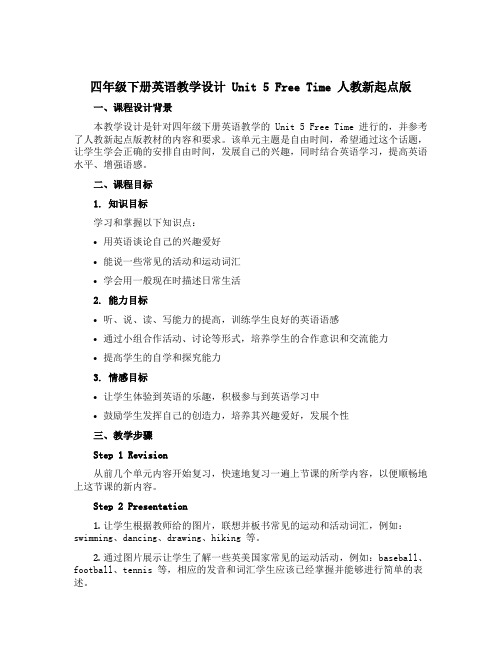
四年级下册英语教学设计 Unit 5 Free Time 人教新起点版一、课程设计背景本教学设计是针对四年级下册英语教学的 Unit 5 Free Time 进行的,并参考了人教新起点版教材的内容和要求。
该单元主题是自由时间,希望通过这个话题,让学生学会正确的安排自由时间,发展自己的兴趣,同时结合英语学习,提高英语水平、增强语感。
二、课程目标1. 知识目标学习和掌握以下知识点:•用英语谈论自己的兴趣爱好•能说一些常见的活动和运动词汇•学会用一般现在时描述日常生活2. 能力目标•听、说、读、写能力的提高,训练学生良好的英语语感•通过小组合作活动、讨论等形式,培养学生的合作意识和交流能力•提高学生的自学和探究能力3. 情感目标•让学生体验到英语的乐趣,积极参与到英语学习中•鼓励学生发挥自己的创造力,培养其兴趣爱好,发展个性三、教学步骤Step 1 Revision从前几个单元内容开始复习,快速地复习一遍上节课的所学内容,以便顺畅地上这节课的新内容。
Step 2 Presentation1.让学生根据教师给的图片,联想并板书常见的运动和活动词汇,例如:swimming、dancing、drawing、hiking 等。
2.通过图片展示让学生了解一些英美国家常见的运动活动,例如:baseball、football、tennis 等,相应的发音和词汇学生应该已经掌握并能够进行简单的表述。
3.在学生熟悉新词汇之后,可分小组讨论,让学生分享自己感兴趣的活动和运动,并在小组内使用所学到的单词进行表述。
Step 3 Practice1.老师播放带有单词的音频,让学生尝试跟读,并根据不同的动作模仿发音和动作。
2.让学生以小组为单位进行对话,询问和回答一些关于休闲时间的问题,例如:What do you like to do in your free time? Do you like sports? What’s your favorite sport? Why do you like it?Step 4 Production1.让学生以小组为单位创作海报,介绍自己喜欢的运动或活动,并用英文写出其名称、介绍、图片等。
2022人教版(新起点)四下Unit 5《Free Time》(Story Time)教案

Unit5 Story Time教学设计【内容来源】人民教育出版社〔一起点〕四年级下册Unit5【主题】Free Time【课时】第7课时:Story Time一、本课教学目标1. 能够借助图片和其他阅读策略读懂故事,完成故事后的表格。
2. 能够在教师的指导下朗读故事;能够复述或表演故事。
3. 能够通过阅读故事明白单单喜欢一件事是不够的,还要经常去做,让这项活动对自己的生活产生正面的影响。
教学建议1.热身活动。
(1) 唱歌曲。
师生共同演唱本单元歌曲。
(2) 海报展示。
学生展示并介绍前一节课制作的海报。
(3)趣味活动分享。
提前请学生从网络搜集一些国外小朋友经常进行的课余活动,与中国小朋友经常从事的课余活动比照,从中找一找相同点和不同点,在课堂上简单以图片等方式与同学分享。
2. 阅读故事;(1)预测。
教师出示本故事的第一张图片,让学生思考:What do you see in the picture What’s wrong with the boy Why does he feel tired引导学生根据自己的生活经验猜一猜小男孩为什么会感觉身体不适。
教师将学生的猜测简单记录在黑板上。
(2)图片环游。
教师依次出示故事图片,以提问的方式引发学生思考讨论。
图片①参考提问:What’s the boy’s name What’s wrong with him然后请学生尝试自行阅读图下方的文字。
其余图片环游过程都依据图片①的教学步骤进行。
图片②参考提问:What’s the boy’s problemDoes the boy like exerciseDo you often feel tiredWhat will you do when you are tired在讨论图②时,两个主人公说的语言都不是非常直接,学生可能在理解上存在一定困难。
教师可以从女生的话语“Why We are walking, not running.〞入手,引导学生思考:Why does the girl say that they are walking, not runningWhy does the boy feel tired even when he is walking帮助学生理解walking是一项很平缓的运动,男生却仍感觉疲劳,这可能是因为他不经常运动造成的。
Unit5+Free+Time+Story+time(课件)人教新起点英语四年级下册+
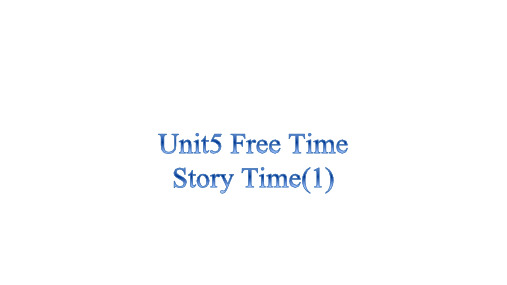
What does he think of it?
reading
Why is Lu Qi tired?
hobbies
I like…
I’m tired/happy.
do different activities
enjoy free time in a healthy way
often do sports
strengths
I‘m good at…
1.在图片的帮助下,理解故事,梳理Lu Qi的健康问题、原因以及解决 办法。
Look and say
Look and say.
Why is the boy tired?
What does he do in his free time?
Let’s talk.
when I…
I’m tired .
…
Why is Lu Qi tired?
What are they doing?
Learning points in the story.
play ping-pong
dance
do exercise
play football
entertainments chores
sports
…
free time activities
frequency
feeling s
Lesson 4
I …once/twice a week.
Let’s talk !
What don do you …?
Story time
Who is he? What’s the matter with him?
2019春人教版(新起点)英语四下Unit-5《Free-Time》(Fun-Time)教学设计

2019春人教版(新起点)英语四下Unit-5《Free-Time》(Fun-Time)教学设计Unit5 Fun Time教学设计【内容来源】人民教育出版社(一起点)四年级下册Unit5【主题】Free Time【课时】第6课时:Fun Time一、本课教学目标1、能够借助图片读懂有关课余活动介绍的短文:2、能够模仿范例进行小制作.3、能够跟着录音欣赏并演唱C项的歌曲.教学建议A、Good to know、1、热身活动.(1) 头脑风暴(Brainstorming).教师说出一个动词,如:go,play等,要求学生尽量多地说出由这个动词构成的短语.教师将这些短语快速记录在黑板上,也可以邀请几个能力较强的学生帮助记录.(2) 小组讨论.小组根据头脑风暴活动形成的板书,谈一谈自己经常做哪些活动,活动的频率等.2、学习A项内容.(1) 导入.教师通过语言引发学生阅读兴趣:We often do many interesting activities in our free time、Today we will read to find out four interesting activities、Read and choose your favourite one from the four、(2) 呈现A项图片,让学生根据图片想一想图片中的小朋友正在做什么.学生如果不会说其中的关键词,教师可以板书这些词在黑板上,如:pet, cook, gardening, knit.(3) 学生独立阅读A项四个小语段,借助图片猜测生词的意思,并了解每个语段的大意.(4) 教师引导学生说一说自己最喜欢这四种活动的哪一种及其理由.根据学生的答案依次引导学生聚焦这四个活动.(5) 播放录音,帮助学生理解语段.新词汇学习pet: 宠物,一般指家养的动物,如猫、狗等,也可以是其他动物,如:pet rabbits, pet birds.可以组成pet shop (宠物商店)和pet food (宠物食品)等短语.take care of: 照顾.常用动词短语,可以让学生多多练习这个非常有用结点.其中“学会生存”是前提.当今,中国小学生的生活自理能力的现状不容乐观.据近年来某中国大城市的调查,超过50%的小学生长期由家长整理生活用品,70%多的小学生在生活上离开父母就束手无策,只有10%左右的学生偶尔做些简单的家务活,平均每人每天做家务的时间还不够半个小时.在这方面,西方一些国家普遍强调,要通过家务劳动使小学生从小养成自立、自理的习惯和做生活主人的意识.这些国家小学生参加家务劳动的情况要好很多.在德国,父母很重视孩子劳动观念的培养.大多数家庭都会为孩子列“家务清单”.家务清单制作得很精美,孩子每个年龄段主要做的家务都清清楚楚地列在了上面.如:4至5岁:不仅要熟练掌握2至3岁要求的家务,还要擦桌子和椅子;独自铺床、吃完饭后把脏碗拿到水池边;妈妈做饭时在旁边帮忙;帮助妈妈把叠好的干净衣服放回衣柜;浇花.5至6岁:照顾宠物;拖地板或者用吸尘机洗地毯;倒垃圾;秋天时帮助父母扫落叶;整理房间;自己准备第一天要穿的衣服;把洗干净的餐具放回橱柜.在每个家务清单后面,还有简单的对父母的要求,比如要多鼓励孩子,让他们带着愉快的心情参与家务活动;孩子做家务时要陪在孩子身边,与他们一起分享劳动成果.当孩子完成一件家务时,要发放小奖品或语言表本奖励等.美国儿童的家务清单与德国相似,它的小学生家务清单如下:6至7岁:不仅要熟练做好2至5岁要求的家务,还要能在父母的帮助下洗碗盘,能独立打扫自己的房间.7至12岁:不仅要熟练做好前几个阶段要求的家务,还要能做简单的饭;帮忙洗车;吸尘擦地;清理洗手间、厕所;扫树叶,扫雪;会用洗衣机和烘干机;把垃圾箱搬到门口街上由垃圾车来收走.13岁以上:不仅要熟练做好前几个阶段要求的家务,还要能换灯泡;换吸尘器里的垃圾袋;擦玻璃;清理冰箱;清理炉台和烤箱;做饭;列出要买的东西的清单;洗衣服(全过程,包括洗衣、烘干衣物、叠衣并放回衣柜);修理草坪.由此可见,父母和学校从孩提起就应为孩子创造一种环境和条件,对孩子进行早期劳动训练,让孩子做力所能及的事情,让孩子养成一双勤劳手,使其终身受益.(6) 播放A项录音材料,学生边听录音指句子.教师提示学生关注发音,尤其是自己不确定的读音,更要认真去听.(7) 再听录音,跟读语段.B、Let’s make、1、同伴交流.学生两人一组,交流自己的课余生活,决定制作海报的内容.2、学生独立完成海报制作.3、完成的学生将海报贴在黑板上,并欣赏他人的海报.如果本节课时间不充分,可以将其作为课后作业留给学生完成.备选活动活动1: 制作课余生活清单.要求学生课余时间设计自己一周的课余生活清单.在清单里将自己从周一到周日七天时间内要参加的课余活动名称、大致的时间和次数、和谁参加、参加的理由等各项内容设计好.可以绘图加以装饰.最后在全班展示活动清单,并选出优秀的清单,并将作品放人学生的形成性评价档案袋里.活动2: 制作“我喜爱的活动”海报.可将B部分内容替换成为自己最喜爱的活动设计推荐海报的活动.首先画图,然后模仿A部分,写几句自己进行此项活动的感受或收获,推荐其他同学也来尝试参加.C、Let s sing、1、教师播放C项歌曲,学生边听边感知和熟悉歌曲的节奏和旋律.2、学生看课本第75页歌词,尝试跟着录音学唱歌曲.最后尝试自己唱一唱歌曲.3、跟随伴奏,全班一起演唱歌曲.【教学反思】。
- 1、下载文档前请自行甄别文档内容的完整性,平台不提供额外的编辑、内容补充、找答案等附加服务。
- 2、"仅部分预览"的文档,不可在线预览部分如存在完整性等问题,可反馈申请退款(可完整预览的文档不适用该条件!)。
- 3、如文档侵犯您的权益,请联系客服反馈,我们会尽快为您处理(人工客服工作时间:9:00-18:30)。
Unit5 Story Time
【内容来源】人民教育出版社(一起点)四年级下册 Unit5
【主题】Free Time
【课时】第7课时:Story Time
一、本课教学目标
1. 能够借助图片和其他阅读策略读懂故事,完成故事后的表格。
2. 能够在教师的指导下朗读故事;能够复述或表演故事。
3. 能够通过阅读故事明白单单喜欢一件事是不够的,还要经常去做,让这项活动对自己的生活产生正面的影响。
教学建议
1. 热身活动。
(1) 唱歌曲。
师生共同演唱本单元歌曲。
(2) 海报展示。
学生展示并介绍前一节课制作的海报。
(3) 趣味活动分享。
提前请学生从网络搜集一些国外小朋友经常进行的课余活动,与中国小朋友经常从事的课余活动对比,从中找一找相同点和不同点,在课堂上简单以图片等方式与同学分享。
2. 阅读故事;
(1) 预测。
教师出示本故事的第一张图片,让学生思考:What do you see in the picture? What’s wrong with the boy? Why does he feel tired?
引导学生根据自己的生活经验猜一猜小男孩为什么会感觉身体不适。
教师将学生的猜测简单记录在黑板上。
(2) 图片环游。
教师依次出示故事图片,以提问的方式引发学生思考讨论。
图片①参考提问:What’s the boy’s name? What’s wrong with him? 然后请学生尝试自行阅读图下方的文字。
其余图片环游过程都依据图片①的教学步骤进行。
图片②参考提问:
What’s the boy’s problem?
Does the boy like exercise?
Do you often feel tired?
What will you do when you are tired?
在讨论图②时,两个主人公说的语言都不是非常直接,学生可能在理解上存在一定困难。
教师可以从女生的话语“Why? We are walking, not running.”入手,引导学生思考:Why does the girl say that they are walking, not running?
Why does the boy feel tired even when he is walking?
帮助学生理解walking是一项很平缓的运动,男生却仍感觉疲劳,这可能是因为他不经常运动造成的。
也可以问问学生:
What does the girl think of the boy?
What do you think of the boy?
What should he do?
自然过渡到 He needs more exercise,
图片③参考提问:
Does the boy like exercise?
What sports does he like? j
Do you like these sports?
What sports do you like to do?
How often do you do sports?
图片④参考提问:
What other sports does the boy like?
How often do they have a dance class?
Do you like dancing?
How often do you go to a dance class?
图片⑤参考提问:
Why does the girl feel confused?
Why is the boy usually tired?
图片⑥参考提问:
Does the boy often do sport?
How often does he play football/ping - pong/go to the dance class?
Do you think he really likes sports?
(3) 学生自己整体阅读故事文本。
学生整体阅读故事。
阅读后,教师借助故事挂图带领学生讲故事,从头到尾地简单讲一遍,加深学生对故事的整体印象。
(4) 完成B项填表。
教师先通过语言布置任务:Lu Qi doesn’t do sports very often, so he often feels tired. Would you like to help him make an exercise plan?
学生两人一组简单讨论:How often should he play football/ping-pong/ go to the dance class? What other sports are good for him?
学生根据讨论自行完成B部分填表任务。
教师邀请几名学生介绍他们为Lu Qi制订的锻炼计划。
教师可以用评选“Best Plan”(最佳计划)的形式引导学生思考计划的合理性,对学生制订的计划进行评价。
(5) 听录音跟读。
教师播放两遍录音。
第一遍,学生听录音,指读文字部分,此时不要求学生跟读。
第二遍,学生尝试跟读故事,模仿语音,语调。
(6) 学生自行朗读故事。
学生出声朗读故事,教师巡视,对有困难的学生提供适时帮助。
(7) 两人一组分角色朗读故事。
学生自主朗读之后,教师引导学生两人结成一组,练习分角色朗读故事。
学生分成六人小组,三对学生依次向同组学生展示。
组内进行互评,给出改进意见。
教师请若干组学生在全班内进行展示。
备选活动
制订课余活动计划。
教师可以为学生提供一周七天的计划表格,请学生安排自己的课余活动计划,并进行交流。
师生可以一同讨论谁制订的计划最合理,谁的课余生活最有趣,发展学生统筹规划的能力。
【教学反思】。
